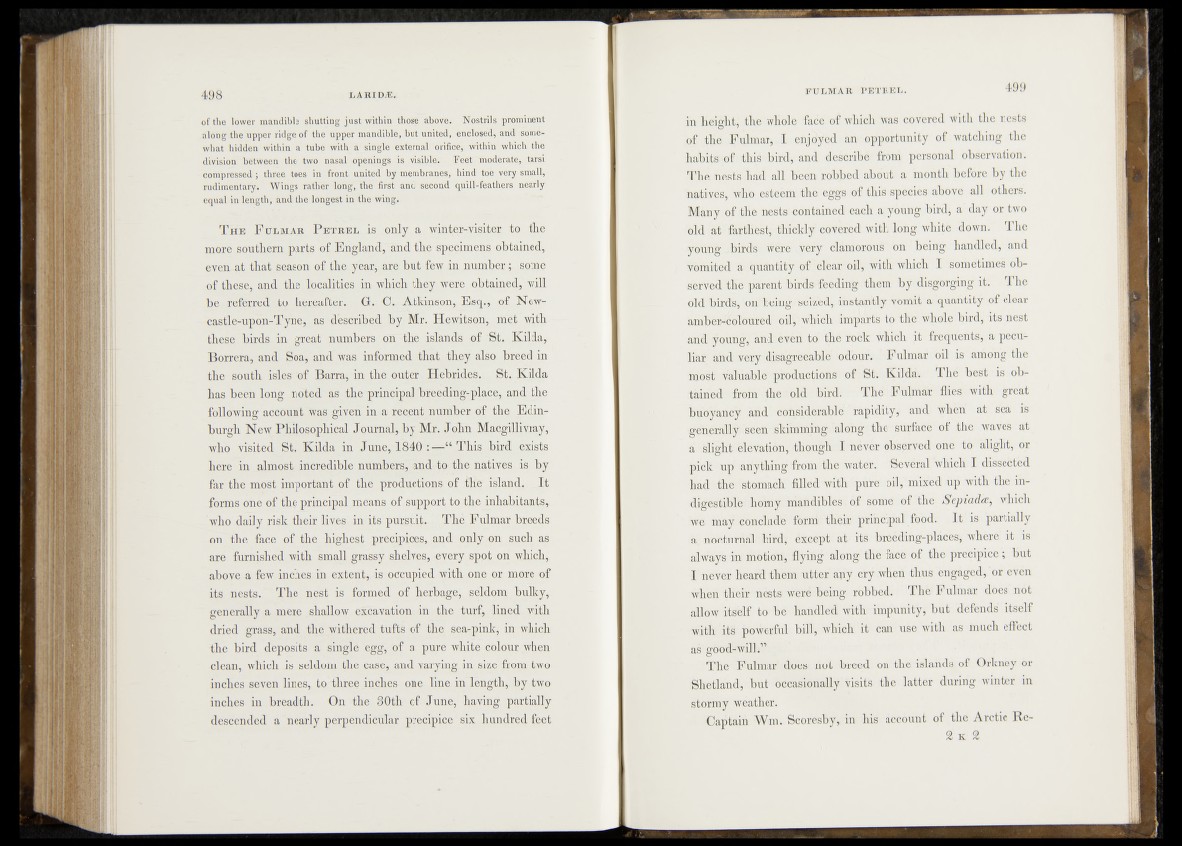
of the lower mandible shutting just within those above. Nostrils prominent
along the upper ridge of the upper mandible, but united, enclosed, and somewhat
hidden within a tube with a single external orifice, within which the
division between the two nasal openings is visible. Feet moderate, tarsi
compressed; three toes in front united by membranes, hind tóe very small,
rudimentary. Wings rather long, the first and second quill-feathers nearly
equal in length, and the longest in the wing.
T he F ulmar P etrel is only a winter-visiter to the
more southern parts of England, and the specimens obtained,
even at that season of the year, are but few in number; some
of these, and the localities in which they were obtained, will
be referred to hereafter. G. C. Atkinson, Esq., of Newcastle
upon-Tyne, as described by Mr. Hewitson, met with
these birds in great numbers on the islands of St. Kilda,
Borrera, and Soa, and was informed that they also breed in
the south isles of Barra, in the outer Hebrides. St. Kilda
has been long noted as the principal breeding-place, and the
following account was given in a recent number of the Edinburgh
New Philosophical Journal, by Mr. John Macgillivray,
who visited St, Kilda in June, 1840 :—“ This bird exists
here in almost incredible numbers, and to the natives is by
far the most important of the productions of fhe island. _It
forms one of the principal means of support to the inhabitants,
who daily risk their lives in its pursuit. Thé Fulmar breeds
on the face of the highest precipices, and only on such as
are furnished with small grassy shelves, every spot on which,
above a few inches in extent, is occupied with one or more of
its nests. The nest is formed of herbage, seldom bulky,
generally a mere shallow excavation, in the turf, lined with
dried grass, and the withered tufts of the, sea-pink, in which
the bird deposits a single egg, of a pure white colour when
clean, which is seldom the case, and varying in size from two
inches seven lines, to three inches one line in length, by two
inches in breadth. On the 80th of June, having partially
descended a nearly perpendicular precipice six hundred feet
in height, the whole face of which was covered with the nests
of the Fulmar, I enjoyed an opportunity of watching the
habits of this bird, and describé from personal observation.
The nests had all been robbed about a month before by the
natives, who esteem the eggs of this species above all others.
Many of the nests contained each a young bird, a day or two
old at farthest, thickly covered with long white down. The
young thirds were .very clamorous on being handled, and
vomited a quantity of clear oil, with which I sometimes observed
the parent birds-feeding them by disgorging it. The
old birds, on being seized, instantly voniit a quantity of clear
amjperrcoloured Oil, which imparts to the whole bird, its nest
and young, and éven to the rock which it frequents, a peculiar
and very disagreeable odour. Fulmar oil is among the
most valuable productions of St. Kilda. Thé best is obtained
from the - old bird. The Fulmar flies with great
buoyancy and considerable rapidity,> and when at sea is
generally seen skimming along the surface of the waves at
a slight elevation, though I néver observed one to alight, or
pick up anything from the water. Sevéral Which I dissected
had the stomach filled with pure oil, mixed up with the indigestible
horny mandibles of some of the Sepiada^ which
we may conclude form their principal food. I t is partially
a nocturnal bird, except at its breeding-places, where it is
always in motion, flying along the face of the precipice; but
I never heard them utter any cry when thus engaged, or even
when their nests weré being robbed. The Fulmar does not
allow itself to be handled with impunity, but defends I itself
with its powerful bill, which it can use with as much effect
as good-will.”
The Fulmar does not breed on the islands of Orkney or
Shetland, but occasionally Visits the latter during winter in
stormy weather.
Captain Wm. Scoresby, in his account of the Arctic Re-
2 x 2